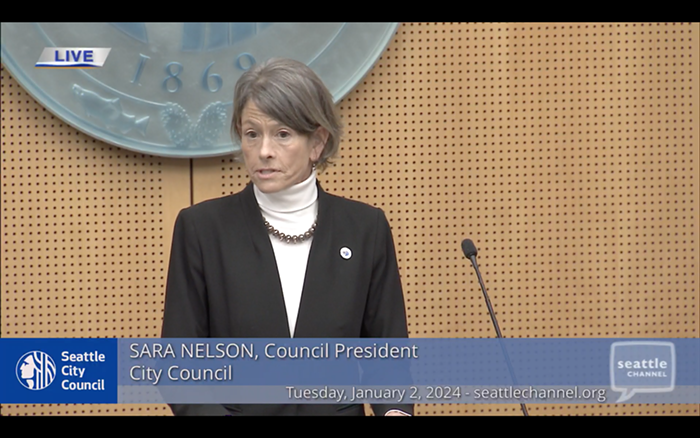
In the spring of 2014, low-income tenants at an apartment building in Ballard had taken on what has become a classic Seattle battle: fighting a wealthy real estate developer.
The building, called the Lockhaven, had once offered apartments from $650 to $1,050 a month, an affordable anomaly in an increasingly unaffordable city.
"At my income level, there’s not a lot of housing out there," Michelle Kinnucan, a resident of the building and middle-aged veteran on disability, told Ansel as she and her neighbors were fighting the real estate company that had recently bought the building.
Kinnucan hadn’t expected the affordable home she already lived in to disappear. After Goodman Real Estate, a Seattle-based developer with projects all over the region, bought the Lockhaven, the building got a new name and shiny new branding. Apartments there are now available for rents between $1,500 and $2,400 a month—more than double the old rates.
Kinnucan isn't the only Seattlite who has noticed the city's existing affordable housing stock slipping away. Even while the city focuses on building new affordable housing, it's losing some of the cheap spots that already exist.
"We have no strategy in our affordable housing goals to deal with preservation," says Seattle City Council member Lisa Herbold. "I think that is a big problem."
Now, Herbold is pitching an idea to solve that problem: Sell city bonds to save affordable apartment buildings and pay back those bonds with tax revenue from new construction.
This stuff can get pretty wonky, but it helps to think about it in terms of the Lockhaven example.

When the Lockhaven went up for sale, Goodman, as a private developer, was able to get its financing together and buy the building, knowing it could make some improvements and then rent it on the private market for higher prices. That process takes longer for nonprofit developers who want to preserve a building for its low-income tenants. It can take months or years for a nonprofit developer like the Low Income Housing Institute to get its financing together. That means that when buildings like the Lockhaven come up for sale, private developers usually have a leg up in buying them. That's bad for renters like Kinnucan.
"You need an open door so people can come in and apply [for funding] when the building's at risk," LIHI Executive Director Sharon Lee told city council members recently.
That's where Herbold's idea comes in.
Herbold wants to create a pot of money—funded by the sale of city bonds—that would be available when affordable buildings like the Lockhaven come up for sale. If such a fund existed a couple of years ago, maybe LIHI or another nonprofit could have used it to buy the Lockhaven and keep it affordable.
Bonding for affordable housing is an idea lefties in Seattle have talked about a lot, but they haven’t found a source of money to pay back those bonds that doesn’t spook the city’s budget department or mayor. Council Member Kshama Sawant has proposed increasing taxes on big businesses and the wealthy. Lee has said the city should tax Airbnb hosts.
Herbold’s plan would use property taxes charged on newly constructed buildings to pay back the bonds. Herbold believes new luxury buildings going up all over town are driving up rents and making buildings like the Lockhaven more vulnerable, so she wants to link that new construction to offsetting displacement.
Just how much money are we talking? According to one hypothetical case from the city's budget office, here's what it would take to save just one 50-unit apartment building: The building would cost about $13.5 million. Of that, a nonprofit developer would kick in about half from its own sources and the city would use money from selling bonds to pay the other half. To pay back the bonds, the city would need about $375,000 each year for 20 years. That $375,000 would come from a "growth fund," paid for by the property taxes on new construction. (A legislative aide says Herbold’s office is still working to answer the question of what would happen if construction revenues declined dramatically due to, say, another recession.)
The mayor's office and some city council members are already pushing back on this idea.
The crux of the disagreement: Are these tax dollars Herbold wants to tap into new revenue or would they require cuts to other city-funded programs? Technically speaking, when a shiny new building comes onto the tax roll, those tax dollars are new for the city. The building didn't exist before, so its owners weren't paying the same level of property taxes. Because of that, Herbold sees this money as fair game for her idea.
The mayor's office disagrees. Those dollars are an expected part of the city's general fund, which pays for things like police and human services, says mayoral spokesperson Viet Shelton.

Shelton says the executive branch is "anxious" that diverting money from the general fund to housing could mean cutting other programs. Revenues from new construction are currently helping to backfill a gap in funding caused by a Tim-Eyman-sponsored limit on how much the city can increase property taxes each year.
"Even with new construction, our property tax base is not going to keep up with inflation," Shelton says. That means that when the construction taxes roll in each year, they’re needed for basic services, Shelton says.
The mayor’s office is focused on other housing ideas. They pushed for a tax credit for landlords who offer affordable units, but that effort died in Olympia this year. Now, they're focused on doubling the housing levy. But advocates say the levy doesn't do enough for preservation. Of the $201 million the levy would raise for 2,100 units of affordable housing, Shelton says most of that will go toward new construction, not preservation.
Given the skepticism from the mayor and other council members, it'll likely take many more months of discussion before Herbold's plan gets a vote. But if Herbold is successful, she will accomplish two things.
First, she will have inserted the city as a stakeholder in the private housing market in a new way. Former Tenants Union head Jon Grant says “the largest portion of affordable housing comes from privately owned buildings," but without policies like rent control, the city currently does little to intervene in the private rental market.
Second, the legislation would cement Herbold's name as a housing leader on the new city council. While Sawant has been talking about bonding for affordable housing for years, success on this idea would take a swipe at the socialist's proprietary brand: Herbold could become the populist in town who knows how to get shit done.
This post has been updated.


















